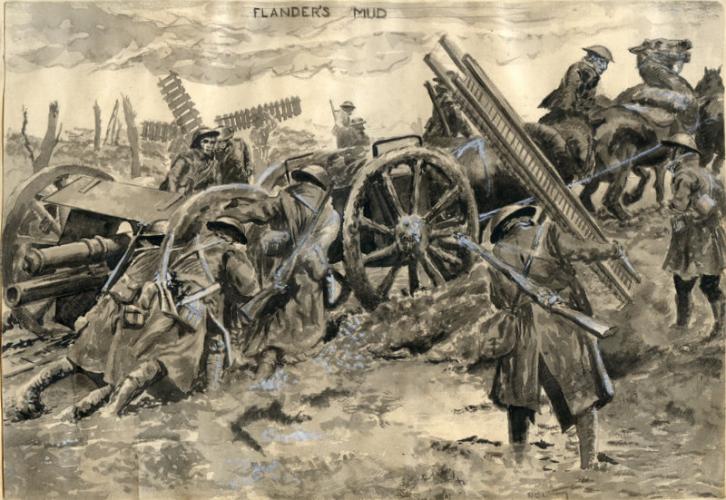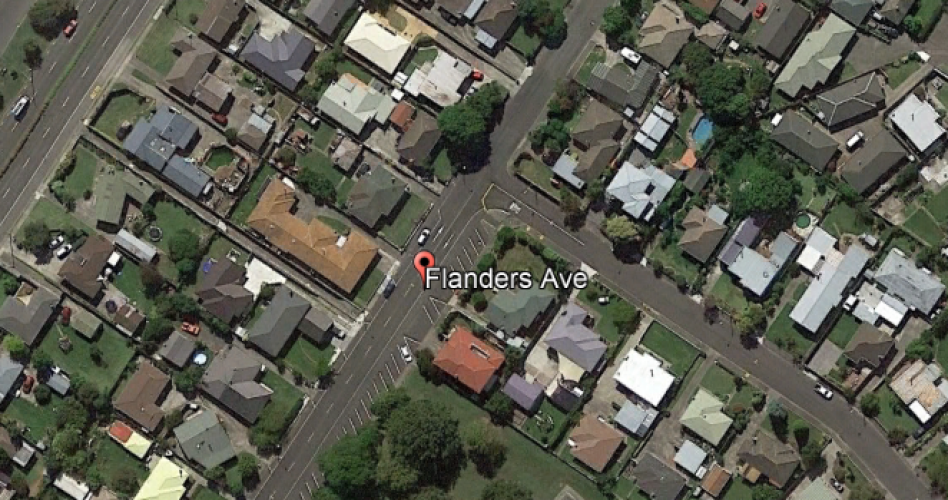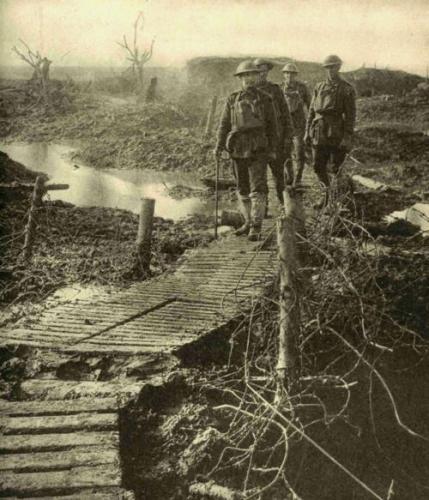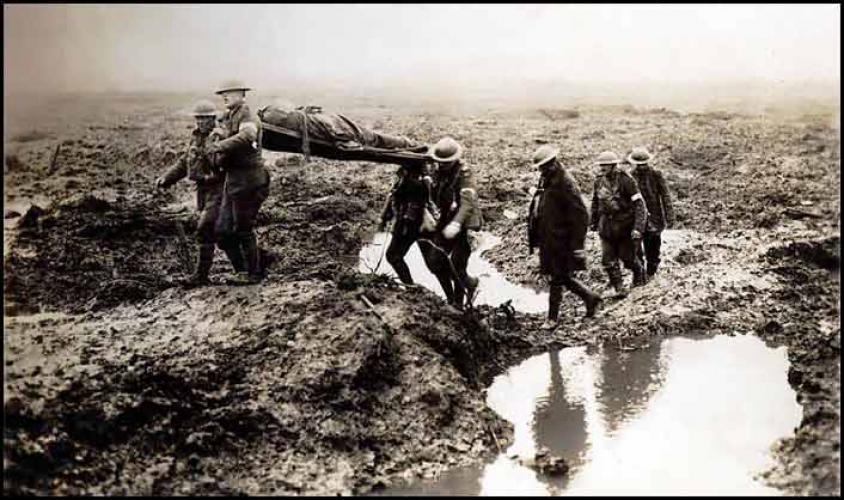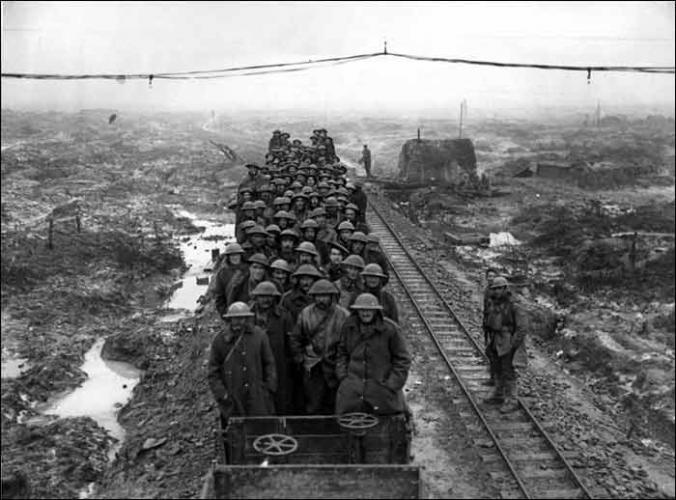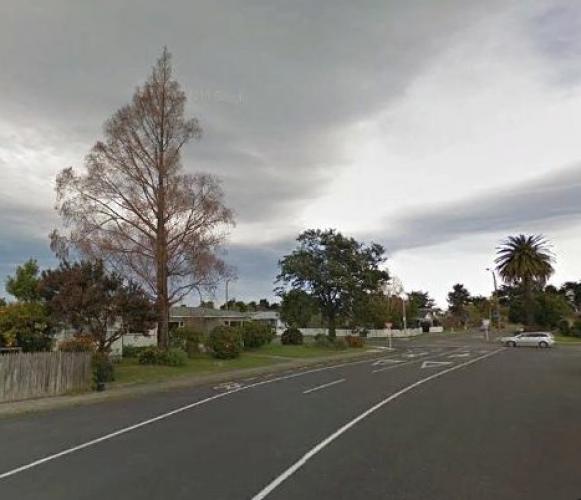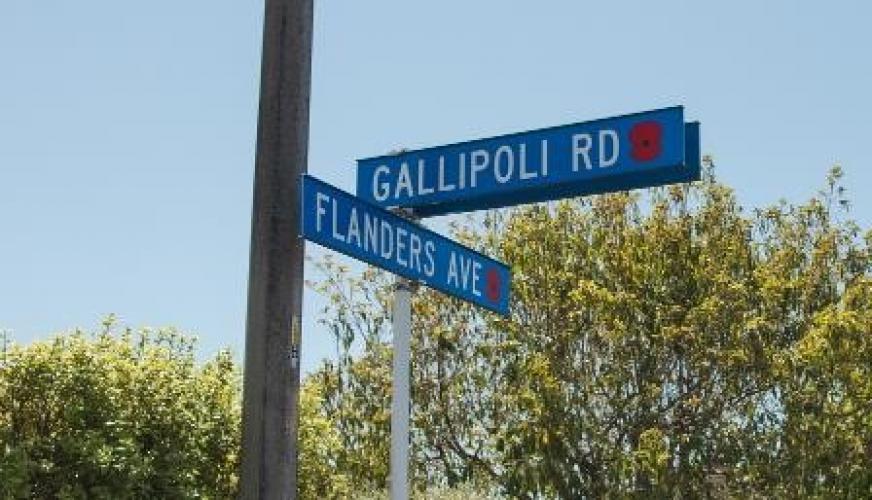026 Flanders Avenue Napier, street scene 2017
Reason for the name
This Napier street was named in honour of the famous battlefield of Flanders. The name Flanders is particularly associated with battles that took place in the Ypres Salient. For the most of WW1 the front line ran continuously from south of Zeebrugge on the Belgian coast, across Flanders Fields into the centre of Northern France before moving eastwards - and it was known as the Western Front.
Flanders Avenue in the suburb of Onekawa Napier is one of several streets named in honour of overseas military service from the two world wars.
Flanders Fields is a common English name of the World War I battlefields in an area straddling the Belgian provinces of West Flanders and East Flanders as well as the French department of Nord-Pas-de-Calais, part of which makes up the area known as French Flanders. The name Flanders Fields is particularly associated with battles that took place in the Ypres Salient, including the Second Battle of Ypres and the Battle of Passchendaele. For most of the war, the front line ran continuously from south of Zeebrugge on the Belgian coast, across Flanders Fields into the centre of Northern France before moving eastwards — and it was known as the Western Front.
Author: Poppy Places Trust
"In Flanders Fields" is a war poem in the form of a rondeau, written during the First World War by Canadian physician Lieutenant-Colonel John McCrae. He was inspired to write it on May 3, 1915, after presiding over the funeral of friend and fellow soldier Lieutenant Alexis Helmer, who died in the Second Battle of Ypres. According to legend, fellow soldiers retrieved the poem after McCrae, initially dissatisfied with his work, discarded it. "In Flanders Fields" was first published on December 8 of that year in the London magazine Punch.
It is one of the most quoted poems from the war. As a result of its immediate popularity, parts of the poem were used in efforts and appeals to recruit soldiers and raise money selling war bonds. Its references to the red poppies that grew over the graves of fallen soldiers resulted in the remembrance poppy becoming one of the world's most recognized memorial symbols for soldiers who have died in conflict. The poem and poppy are prominent Remembrance Day symbols throughout the Commonwealth of Nations, particularly in Canada, where "In Flanders Fields" is one of the nation's best-known literary works. The poem is also widely known in the United States, where it is associated with Memorial Day.
Background
John McCrae was a poet and physician from Guelph, Ontario. He developed an interest in poetry at a young age and wrote throughout his life. His earliest works were published in the mid-1890s in Canadian magazines and newspapers. McCrae's poetry often focused on death and the peace that followed.
At the age of 41, McCrae enrolled with the Canadian Expeditionary Force following the outbreak of the First World War. He had the option of joining the medical corps because of his training and age but he volunteered instead to join a fighting unit as a gunner and medical officer. It was his second tour of duty in the Canadian military. He had previously fought with a volunteer force in the Second Boer War. He considered himself a soldier first; his father was a military leader in Guelph and McCrae grew up believing in the duty of fighting for his country and empire.
McCrae fought in the Second Battle of Ypres in the Flanders region of Belgium, where the German army launched one of the first chemical attacks in the history of war. They attacked French positions north of the Canadians with chlorine gas on April 22, 1915 but were unable to break through the Canadian line, which held for over two weeks. In a letter written to his mother, McCrae described the battle as a "nightmare",
For seventeen days and seventeen nights none of us have had our clothes off, nor our boots even, except occasionally. In all that time while I was awake, gunfire and rifle fire never ceased for sixty seconds.... And behind it all was the constant background of the sights of the dead, the wounded, the maimed, and a terrible anxiety lest the line should give way.
Alexis Helmer, a close friend, was killed during the battle on May 2. McCrae performed the burial service himself, at which time he noted how poppies quickly grew around the graves of those who died at Ypres. The next day, he composed the poem while sitting in the back of an ambulance at an Advanced Dressing Station outside Ypres. This location is today known as the John McCrae Memorial Site.
Poem
In Flanders Fields and Other Poems, a 1919 collection of McCrae's works, contains two versions of the poem: a printed text as below and a handwritten copy where the first line ends with "grow" instead of "blow":
In Flanders fields the poppies blow
Between the crosses, row on row,
That mark our place; and in the sky
The larks, still bravely singing, fly
Scarce heard amid the guns below.
We are the Dead. Short days ago
We lived, felt dawn, saw sunset glow,
Loved and were loved, and now we lie
In Flanders fields.
Take up our quarrel with the foe:
To you from failing hands we throw
The torch; be yours to hold it high.
If ye break faith with us who die
We shall not sleep, though poppies grow
In Flanders fields.
As with his earlier poems, "In Flanders Fields" continues McCrae's preoccupation with death and how it stands as the transition between the struggle of life and the peace that follows. It is written from the point of view of the dead. It speaks of their sacrifice and serves as their command to the living to press on. As with many of the most popular works of the First World War, it was written early in the conflict, before the romanticism of war turned to bitterness and disillusion for soldiers and civilians alike.
Legacy
McCrae was moved to the medical corps and stationed in Boulogne, France, in June 1915 where he was promoted to Lieutenant-Colonel and placed in charge of medicine at the Number 3 Canadian General Hospital. He was promoted to the acting rank of Colonel on January 13, 1918 and named Consulting Physician to the British Armies in France. The years of war had worn McCrae down, he contracted pneumonia that day and later came down with cerebral meningitis. On January 28, 1918, he died at the military hospital in Wimereux and was buried there with full military honours. A book of his works, featuring "In Flanders Fields", was published the following year.
"In Flanders Fields" is very popular in Canada, where it is a staple of Remembrance Day ceremonies and may be the most well-known literary piece among English Canadians. It has an official French adaptation, entitled "Au champ d'honneur", written by Jean Pariseau and used by the Canadian government in French and bilingual ceremonies. With an excerpted appearance on the ten-dollar bill from 2001 to 2013, the Royal Canadian Mint has released poppy-themed quarters on several occasions. A version minted in 2004 featured a red poppy in the centre and is considered the first multi-coloured circulation coin in the world. To mark the poem's centennial in 2015, a coloured and uncoloured poppy quarter and a "toonie" ($2 coin) were issued as circulation coins, as well as other collector coins. Among its uses in popular culture, the line "to you from failing hands we throw the torch, be yours to hold it high" has served as a motto for the Montreal Canadiens hockey club since 1940.
Canada Post honoured the 50th anniversary of John McCrae's death with a stamp in 1968 and marked the centennial of his famous poem in 2015. Other Canadian stamps have featured the poppy, including ones in 1975, 2001, 2009, 2013 and 2014. Other postal authorities have employed the poppy as a symbol of remembrance, including those of Australia, Gibraltar, the United Kingdom and United States.
McCrae's birthplace in Guelph, Ontario has been converted into a museum dedicated to his life and the war. McCrae was named a National Historic Person in 1946, and his house was listed as a National Historic Site in 1966.
In Belgium, the In Flanders Fields Museum in Ypres, named after the poem and devoted to the First World War, is situated in one of Flanders' largest tourist areas. A monument commemorating the writing of the poem is located at Essex Farm Commonwealth War Graves Commission Cemetery, which is thought to have been the location of Helmer's burial and lies within the John McCrae Memorial Site.
Despite its fame, "In Flanders Fields" is often ignored by academics teaching and discussing Canadian literature. The poem is sometimes viewed as an anachronism; it spoke of glory and honour in a war that has since become synonymous with the futility of trench warfare and the slaughter produced by 20th-century weaponry. Nancy Holmes, professor at the University of British Columbia, speculated that its patriotic nature and use as a tool for propaganda may have led literary critics to view it as a national symbol or anthem rather than a poem.
The red poppies that McCrae referred to had been associated with conflict since the Napoleonic Wars when a writer of that time first noted how the poppies grew over the graves of soldiers. The damage done to the landscape in Flanders during the battle greatly increased the lime content in the surface soil, leaving the poppy as one of the few plants able to grow in the region.
Inspired by "In Flanders Fields", American professor Moina Michael resolved at the war's conclusion in 1918 to wear a red poppy year-round to honour the soldiers who had died in the war. She also wrote a poem in response called "We Shall Keep the Faith". She distributed silk poppies to her peers and campaigned to have them adopted as an official symbol of remembrance by the American Legion. Madame E. Guérin attended the 1920 convention where the Legion supported Michael's proposal and was inspired to sell poppies in her native France to raise money for the war's orphans. In 1921, Guérin sent poppy sellers to London ahead of Armistice Day, attracting the attention of Field Marshal Douglas Haig. A co-founder of The Royal British Legion, Haig supported and encouraged the sale. The practice quickly spread throughout the British Empire. The wearing of poppies in the days leading up to Remembrance Day remains popular in many areas of the Commonwealth of Nations, particularly Great Britain, Canada and South Africa and in the days leading up to ANZAC Day in Australia and New Zealand.

